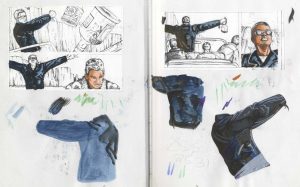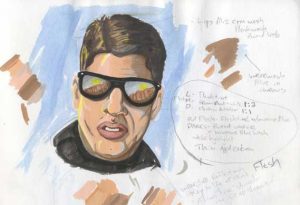The second media that I learned to paint in, after oils, was gouache. Gouache is a watercolor paint that has white added to it so, instead of being transparent like regular watercolor, gouache is opaque. It can also be watered down so you have the choice between transparent and opaque. I had never even heard of gouache until, sometime in my first two years of college, I bought a book on painting techniques throughout history. It was a fascinating book for a young student. It showed what tools and techniques painters through the ages, from fine art to illustration, used to make their paintings. In the entire book I think only one painter used gouache but his images stood out to me. It was bright, vivid, and striking in its use of light.
All through my art school years I never used gouache. No one did. I never heard word one about it. It wasn’t until I was a few years out of school that I decided to try it out for myself. I think the first gouache I bought was a set of pan colors made by Pelican. That’s a cheap and readily available set and I still have and still use. A pan set is one of those sets that has twelve or twenty four little one inch circles of dry paint in them. You put some water drops on top of the paint to wet it and then drag your brush in the paint. To that pan set I also added some tubes of gouache. There are a lot of different colors available in tubes. The tubes are often referred to as “Designer’s Gouache” because they dry to a flat and consistent color. In the days before computers graphic designers used to use them to make designs with.
I recently dug out one of my old sketchbooks from the days when I was first learning to use gouache. Annoyingly the sketchbook was from before the time when I consistently dated things. A whole sketchbook without one date in it. Let that be a lesson to you to put a date on things. You might not care at the moment but twenty years on and a little context would be nice. Luckily a few pages after my gouache work were some sketches I did for the back of my coat and I know when I bought the duster having recently stumbled across the receipt for it in an old box of such stuff. I bought the coat in July of 1993 so I must have been first learning to use gouache in the spring of 1993. There is a date that I didn’t know yesterday.
This is my illustrative gouache approach. With it I was painting real things in a semi-real way. In these painting I’m working on a fully painted comic book. It takes a ton of work to fully paint a comic book but I was interested in both learning to paint in gouache and in cartooning so I joined the two together for a little while. I don’t believe I ever thought about painting a whole big comic but was interested in learning how to. I think I eventually painted six to ten pages of these but these are the practice ones from a sketchbook. I was learning. The first scan is of two pages out of my sketchbook. Here I made some photocopies of the comic book pages I had drawn, glued them down in the book, and painted right over the photocopies. That’s not a technique I used very often but I didn’t want to have to redraw things as I was learning to use the paint. I could always start with another photocopy.

I can see me, all those years ago, trying to figure it out. What should be transparent? What should be opaque? How does that relate to the darks and lights? There are not many answers on this page but I can see the questions. I was beginning to figure out the leather coat on the right hand page but the skin tones are all wrong. They are too dark and too orange. I turned twenty eight in the summer of 1993. I was well past my art school years but I still liked to learn new stuff. I decided to tackle gouache because it appealed to me from a fine art and an illustrative approach. I could do semi-realistic stuff, like this, with it but I could also flesh out some of my odd and colorful images that I normally
would do in oil. Smaller and faster. But first I had to learn.

Here is the first thing you should know when learning a new technique. Write things down. Especially when learning an illustrative painting technique. If you’re going to be painting the same guy’s face over and over then write down what paints you used and in what amounts. Don’t trust yourself to remember from day to day. It could be a week before you get back to it and by then you’ve forgotten if you used carmine or alizarin. Writing down paint recipes saves having to figure out how to bake a cake over and over. That’s also why I decided to work in a sketchbook rather than on individual sheets of paper. I could refer back to it easier. Even two decades later.

The third scan is all about transparent and opaque as applied to the background. It’s mostly transparent. I have a few pages in the sketchbook that are all about this desert landscape. I think I was trying to figure out how to keep it light without it washing away. I kept the figure in the foreground opaque and the backgrounds more transparent.
I still paint in gouache every now and then. I had them out last week and did a small eight by ten inch painting. I hadn’t had them out in a while and realized that I need to re-order them. Over the last few years I’ve learned a couple of new mediums and have tweaker how I organize my paints and could apply that to my older gouache system. But that’s a story for another day.
Discussion ¬